Effects of cartilage impact with and without fracture on chondrocyte viability and the release of inflammatory markers
- PMID: 23620164
- PMCID: PMC3966619
- DOI: 10.1002/jor.22348
Effects of cartilage impact with and without fracture on chondrocyte viability and the release of inflammatory markers
Abstract
Post-traumatic arthritis (PTA) frequently develops after intra-articular fracture of weight bearing joints. Loss of cartilage viability and post-injury inflammation have both been implicated as possible contributing factors to PTA progression. To further investigate chondrocyte response to impact and fracture, we developed a blunt impact model applying 70%, 80%, or 90% surface-to-surface compressive strain with or without induction of an articular fracture in a cartilage explant model. Following mechanical loading, chondrocyte viability, and apoptosis were assessed. Culture media were evaluated for the release of double-stranded DNA (dsDNA) and immunostimulatory activity via nuclear factor kappa B (NF-κB) activity in Toll-like receptor (TLR) -expressing Ramos-Blue reporter cells. High compressive strains, with or without articular fracture, resulted in significantly reduced chondrocyte viability. Blunt impact at 70% strain induced a loss in viability over time through a combination of apoptosis and necrosis, whereas blunt impact above 80% strain caused predominantly necrosis. In the fracture model, a high level of primarily necrotic chondrocyte death occurred along the fracture edges. At sites away from the fracture, viability was not significantly different than controls. Interestingly, both dsDNA release and NF-κB activity in Ramos-Blue cells increased with blunt impact, but was only significantly increased in the media from fractured cores. This study indicates that the mechanism of trauma determines the type of chondrocyte death and the potential for post-injury inflammation.
Copyright © 2013 Orthopaedic Research Society.
Figures
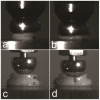
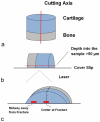

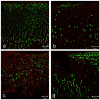
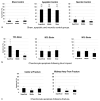



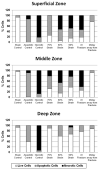
Similar articles
-
Cartilage viability and catabolism in the intact porcine knee following transarticular impact loading with and without articular fracture.J Orthop Res. 2011 Apr;29(4):501-10. doi: 10.1002/jor.21270. Epub 2010 Nov 4. J Orthop Res. 2011. PMID: 21337389 Free PMC article.
-
Viability and volume of in situ bovine articular chondrocytes-changes following a single impact and effects of medium osmolarity.Osteoarthritis Cartilage. 2005 Jan;13(1):54-65. doi: 10.1016/j.joca.2004.10.007. Osteoarthritis Cartilage. 2005. PMID: 15639638
-
Chondrocyte viability is lost during high-rate impact loading by transfer of amplified strain, but not stress, to pericellular and cellular regions.Osteoarthritis Cartilage. 2019 Dec;27(12):1822-1830. doi: 10.1016/j.joca.2019.07.018. Epub 2019 Sep 14. Osteoarthritis Cartilage. 2019. PMID: 31526876 Free PMC article.
-
Basic science of intra-articular fractures and posttraumatic osteoarthritis.J Orthop Trauma. 2010 Sep;24(9):567-70. doi: 10.1097/BOT.0b013e3181ed298d. J Orthop Trauma. 2010. PMID: 20736796 Free PMC article. Review.
-
Effects of shear stress on articular chondrocyte metabolism.Biorheology. 2000;37(1-2):95-107. Biorheology. 2000. PMID: 10912182 Review.
Cited by
-
The P2X7 Receptor in Osteoarthritis.Front Cell Dev Biol. 2021 Feb 11;9:628330. doi: 10.3389/fcell.2021.628330. eCollection 2021. Front Cell Dev Biol. 2021. PMID: 33644066 Free PMC article. Review.
-
Harnessing joint distraction for the treatment of osteoarthritis: a bibliometric and visualized analysis.Front Bioeng Biotechnol. 2023 Nov 9;11:1309688. doi: 10.3389/fbioe.2023.1309688. eCollection 2023. Front Bioeng Biotechnol. 2023. PMID: 38026890 Free PMC article.
-
The chondrocyte "mechanome": Activation of the mechanosensitive ion channels TRPV4 and PIEZO1 drives unique transcriptional signatures.FASEB J. 2024 Jul 15;38(13):e23778. doi: 10.1096/fj.202400883R. FASEB J. 2024. PMID: 38959010 Free PMC article.
-
Injury-related cell death and proteoglycan loss in articular cartilage: Numerical model combining necrosis, reactive oxygen species, and inflammatory cytokines.PLoS Comput Biol. 2023 Jan 26;19(1):e1010337. doi: 10.1371/journal.pcbi.1010337. eCollection 2023 Jan. PLoS Comput Biol. 2023. PMID: 36701279 Free PMC article.
-
Synergy between Piezo1 and Piezo2 channels confers high-strain mechanosensitivity to articular cartilage.Proc Natl Acad Sci U S A. 2014 Nov 25;111(47):E5114-22. doi: 10.1073/pnas.1414298111. Epub 2014 Nov 10. Proc Natl Acad Sci U S A. 2014. PMID: 25385580 Free PMC article.
References
-
- Brown TD, Johnston RC, Saltzman CL, Marsh JL, Buckwalter JA. Posttraumatic osteoarthritis: a first estimate of incidence, prevalence, and burden of disease. J Orthop Trauma. 2006 Nov-Dec;20(10):739–744. - PubMed
-
- Matta JM. Fractures of the acetabulum: accuracy of reduction and clinical results in patients managed operatively within three weeks after the injury. J Bone Joint Surg Am. 1996 Nov;78(11):1632–1645. - PubMed
-
- Stufkens SA, Knupp M, Horisberger M, Lampert C, Hintermann B. Cartilage lesions and the development of osteoarthritis after internal fixation of ankle fractures: a prospective study. J Bone Joint Surg Am. 2010 Feb;92(2):279–286. - PubMed
-
- Olson SA, Guilak F. From articular fracture to posttraumatic arthritis: A black box that needs to be opened. Journal of Orthopaedic Trauma. 2006 Nov-Dec;20(10):661–662. - PubMed
Publication types
MeSH terms
Substances
Grants and funding
LinkOut - more resources
Full Text Sources
Other Literature Sources
Medical

